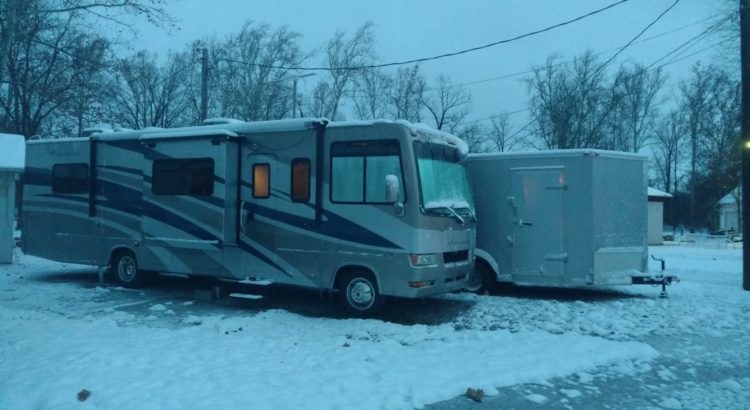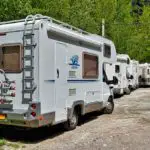I hate to be the bearer of bad news, but if you’re like most people, camping season is coming to an end. That means it is time to prepare for RV winter storage.
If this is your first year RVing, it can be overwhelming. Worst of all, you may worry about missing a step and destroying your rig over the winter. Fortunately, with the right instructions, RV winter storage isn’t as challenging as it seems. Keep reading for all the tips you need to keep the interior of your RV looking and working like new for next season.
Interior RV Winter Storage Checklist
To prepare the interior of your RV for Winter Storage, there are several important steps. Following all these steps will protect your RV. That way, when spring comes, your RV will still be in good shape and ready to hit the road!
Give Your RV Interior a Deep Clean Before Winter
To prevent weird smells, deteriorating interior, or critters, giving your RV a deep clean is a great place to start for RV winter storage. This means vacuuming every nook and cranny, cleaning the bathroom, the sink, and so on.
Basically, now is the perfect time to make your RV as clean as possible before winter. Although the task takes time, you’ll thank yourself come spring. You won’t have nearly as much cleaning to do before your first trip of the season.
Mouse Proof Your RV for Winter Storage
Mice can sneak into your RV through even the tiniest of cracks. Once inside, they can cause a lot of destruction. It is important to seal up all interior and exterior entry points to keep them out.
Additionally, you will want to remove anything that would make for a tasty snack or a cozy nest for a mouse For more details on how to keep mice out of RVs, I’ve written an entire article on the topic.
Drain Your Lines and Tanks
If water is left to sit in your tanks or lines in the winter, it can freeze and expand. This expansion can cause your pipes to burst. Even if you don’t live somewhere with sub-freezing temperatures, draining everything is still a good idea. Leaving water to sit and stagnate for a long time is not recommended.
Algae and other bacteria can grow if your tanks and lines aren’t properly emptied. Also, I hope by now it is obvious why you need to drain your black and grey tanks before winter.
Blow Out Your Lines or Add Antifreeze for RV Winter Storage
Draining your lines alone isn’t enough. That’s because just opening the valves only lets so much water out. In order to get all the water out, you can use an air compressor to blow out the lines by adding a blowout plug.
The easiest option to winterize your RV for storage is to add antifreeze to your freshwater tank, turn on your pump, and run each of your faucets until you only see pink antifreeze coming out. You should also dump some antifreeze in all your p-traps and toilet.
Make sure your water heater is being bypassed. There is a separate drain plug on your water heater that will let you get enough water out to prevent the tank from cracking.
Open Cabinets, Drawers, and Fridge
Opening cabinets and drawers will help reduce the chance of water damage from condensation inside your cabinets. If you make the mistake of leaving your fridge sealed up, you’re likely to have a smelly, moldy problem to deal with come spring. Cracking the door open and adding baking soda will keep things fresh. Some people even use a pool noodle in their RV to prop open doors.
Place DampRid Inside Your RV for Winter Storage
Condensation can build up in the winter. If left unchecked, it can sometimes be enough to cause water damage inside your rig. A simple solution is to add DampRid or a similar product in several places.
Disconnect Your Electrical System
Flip your battery disconnect switch. If you have a motorhome, disconnect the coach power as well. If you live in a colder climate, you should remove your battery to protect it and extend its lifespan. Putting the battery on a battery charger maintainer during the winter, or as needed, is also a good strategy.
Close all Blinds
This simple task will help prevent sun damage to the interior of your RV. It could also prevent people from looking into your RV and seeing something they might like to steal.
Protect Your RV
To protect your valuables, you should remove them before storage. Even RVs stored in secured storage facilities have been broken into. The instances of theft also seem to be on the rise this year. Another option, if your RV is plugged in to power, is to add a security camera. I cover several options in this post about RV temperature monitors and security cameras.
Check on Your RV While it Is Stored for the Winter
Even after completing all these steps, it is wise to check on your RV periodically throughout the winter. If you catch a problem early, it is much simpler to fix. Seasoned RVers, are there any other strategies you use to prepare your RV interior for winter storage?
Up next, find out how to prepare your RV exterior for winter storage.




